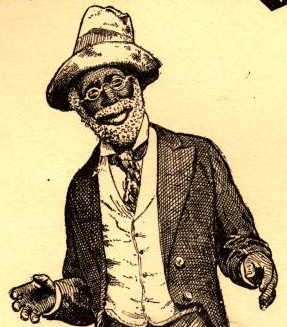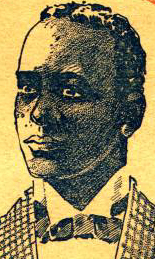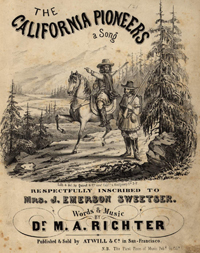African Americans in California Sheet Music
Audio files for this page
 African Americans appear in nineteenth-century sheet music as composers,
performers, emancipated slaves or freemen, and are frequently the subject of
vaudeville or black-face minstrel show lyrics. By the 1860s African Americans
such as Sam Lucas (at left, from "Ole' Nicker Demus, De
Ruler ob de Jews";
Nicodemus, Kansas, was founded as an African American
settlement in 1877) had begun to form their own minstrel troupes and California played its
role in providing access to the stage. The Hyers sisters, soprano
Anna Madah and contralto Emma Louise, were born in Sacramento in the
1850s and trained by a German pianist and Italian opera singer. Their
debut at the Metropolitan Theater in Sacramento on April 22, 1867, received
favorable reviews in the papers (San Francisco Chronicle:
"rare natural gifts would insure for them a leading position among the
prime donne of the age"). Their African American repertory company in
the 1870s brought forth "one of the first musical shows to be produced by a
black theatrical organization" (Sampson, Blacks in Blackface, 393)
(In and Out of Bondage 1877; The Underground Railroad 1879).
Black Patti (Matilda Sissieretta Joyner, 1869-1933) studied at the New
England Conservatory and sang at the White House in 1892. Kept
from the opera stage, she formed "Black Patti Troubadours" and combined
opera arias with the repertoire of vaudeville, touring successfully for
nineteen years. The cover of
"Ma Gal's de Town Talk" by Kentucky-born
African American composer Ernest Hogan (1860-1909)
includes a photograph of
an African American minstrel performer, a charming drawing of an
African American woman, and a reference to the Black Patti Troubadours.
Hogan's "I Loves My Honey" includes
a portrait of the composer (see below) and a drawing of an African American woman.
Bert Williams (Antigua, ca. 1874-1922) entertained in cafes in San Francisco
from an early age, formed a vaudeville team with George Nash Walker in
1895, and in 1896 moved to New York for a successful career on the stage. African Americans appear in nineteenth-century sheet music as composers,
performers, emancipated slaves or freemen, and are frequently the subject of
vaudeville or black-face minstrel show lyrics. By the 1860s African Americans
such as Sam Lucas (at left, from "Ole' Nicker Demus, De
Ruler ob de Jews";
Nicodemus, Kansas, was founded as an African American
settlement in 1877) had begun to form their own minstrel troupes and California played its
role in providing access to the stage. The Hyers sisters, soprano
Anna Madah and contralto Emma Louise, were born in Sacramento in the
1850s and trained by a German pianist and Italian opera singer. Their
debut at the Metropolitan Theater in Sacramento on April 22, 1867, received
favorable reviews in the papers (San Francisco Chronicle:
"rare natural gifts would insure for them a leading position among the
prime donne of the age"). Their African American repertory company in
the 1870s brought forth "one of the first musical shows to be produced by a
black theatrical organization" (Sampson, Blacks in Blackface, 393)
(In and Out of Bondage 1877; The Underground Railroad 1879).
Black Patti (Matilda Sissieretta Joyner, 1869-1933) studied at the New
England Conservatory and sang at the White House in 1892. Kept
from the opera stage, she formed "Black Patti Troubadours" and combined
opera arias with the repertoire of vaudeville, touring successfully for
nineteen years. The cover of
"Ma Gal's de Town Talk" by Kentucky-born
African American composer Ernest Hogan (1860-1909)
includes a photograph of
an African American minstrel performer, a charming drawing of an
African American woman, and a reference to the Black Patti Troubadours.
Hogan's "I Loves My Honey" includes
a portrait of the composer (see below) and a drawing of an African American woman.
Bert Williams (Antigua, ca. 1874-1922) entertained in cafes in San Francisco
from an early age, formed a vaudeville team with George Nash Walker in
1895, and in 1896 moved to New York for a successful career on the stage.
While African Americans may
not have used particular terms to
set themselves apart (as in the song about Civil War soldiers, "Abraham's
Daughter"), whites used a number of terms to denote them. Although many
such terms had negative connotations, their connotation had become so
well-known that African Americans adopted them in their own compositions
(Darktown, coon music, colored fun).
The sheet music project has attempted to bring together music related to African
Americans by subject access using vocabulary acceptable
today. For example, the Library of Congress term
"Afro-American" is the preferred term for the MARC cataloging of records
searched by
Cheshire II. However,
users of the project's alternative search system must search for sheet
music using the title words themselves and so must use the vocabulary of
the period. Titles and lyrics of sheet music reveal contemporary use of such terms
as:
- Negro--The term preferred by African Americans of the time, as
in Clorindy, the Origin of the Cakewalk, a "characteristic
Negro musical comedy" written by
Will Marion Cook and Paul
Laurence Dunbar which introduced a New York
audience to ragtime on the stage of the Casino Theater.
Cook was born in Washington, D.C., in 1869 and when he was 13
began studying violin at the
Oberlin Conservatory where his mother had graduated in 1865. After two years
at Oberlin, he left to attend the University of Berlin, returned to the U.S.
to study with Antonin Dvorak at the National Conservatory of Music, and made
his debut on violin in 1889. Clorindy, his first attempt at theater,
was written for
Bert Williams and his partner but when they were busy Ernest Hogan stepped
in.
Clorindy is represented here by the sheet music
title "Der'll be wahm coons a prancin',"
illustrated with portraits of the African
American performers of the San Francisco production. The composer
George Peck arranged "the most favourite Negro
melodies" for the piano in his The
San Francisco Quadrilles,
published in the 1850s with a cover lithograph of
a goldminer and the new seal of California. "Matilda Brown" (1896) is
called a "Negro song."
- Freemen--A term used in "We're Freemen Now," upon emancipation.
- Coon--A derogatory term for African Americans and by extension
for music that used the rhythmic and harmonic
style of African Americans but was often set with broad dialect lyrics that
caricatured their lives.
 By the end
of the century African Americans
themselves were writing, staging, and performing music
that was in a transition period called "coon music." Ernest Hogan used the
terms coon and darkey in his
"I Loves Ma Honey" (1898); the cover includes his portrait (at left).
The popularity of the
music of "Darktown" is proudly attested to in the lyrics of
"Der'll be wahm
coons a prancin'" which proclaim that a time is coming "when de bes' lak de res' gwine be singing
coon fu' ouh song mighty sweet to hear." Other music that calls itself coon
includes "My Darktown Gal,"
"The New Bully,"
"Nigger, Nigger,"
"The Mission
Band," "I'se Got the Warmest Baby,"
"It Won't Be Very Long,"
"Ma Angeline."
By the end
of the century African Americans
themselves were writing, staging, and performing music
that was in a transition period called "coon music." Ernest Hogan used the
terms coon and darkey in his
"I Loves Ma Honey" (1898); the cover includes his portrait (at left).
The popularity of the
music of "Darktown" is proudly attested to in the lyrics of
"Der'll be wahm
coons a prancin'" which proclaim that a time is coming "when de bes' lak de res' gwine be singing
coon fu' ouh song mighty sweet to hear." Other music that calls itself coon
includes "My Darktown Gal,"
"The New Bully,"
"Nigger, Nigger,"
"The Mission
Band," "I'se Got the Warmest Baby,"
"It Won't Be Very Long,"
"Ma Angeline."
- Ragtime--By the end of the century such genres as ragtime presented the
style of African American music without the negative connotations of crude
dialect and caricature illustrations found in "coon" music. Celebrated
pianist and choreographer
Ned Wayburn composed two piano parts for "Syncopated
Sandy" (1897), one in rag time, and gave an explanation of the genre as
"originating with the negroes and characteristic of their people. The negroe in playing the
piano, strikes the keys with the same time and measure that he taps the floor with
his heels and toes in dancing, thereby obtaining a peculiarly accented
time effect which he terms "rag-time" (p. 2). James A. Marshall and
Walter Wolff wrote and published "Evening
Pastimes" in 1897 and called it
"the only genuine Negro Ragtime ever written."
Another example of ragtime in the California collection is the "ragtime ad lib"
section of "Dat
Bad Coon from Alabama," with a lively right-hand piano part.
- Colored--Though clearly a term used by whites to set off difference,
the sheet music titles "De
Darktown Colored Band," "Happy Colored Man," and
"Yer Baby's a Comin' to Town" ("a darkey song")
acknowledge respected African American performers.
- Ethiopian--A term for minstrel songs, as in the classification of
"Shabby
Genteel" as an "Ethiopian and Comic Song."
- Hottentot--A word used in the nineteenth century for a group of
people in southwest Africa. The illustration of children riding a crocodile
on "The
Happy Hottentots" places African Americans in a fantastic other land.
- Black--A term often used in minstrel shows performed by whites (see
"I'se
Her Black-an'-Tan Adonis" and "I'll
Make Dat Black Gal Mine") but also
a term for the emancipated slave, as in Stephen Foster's "Old
Black Joe" with
its sentimental illustrations that recall Stowe's Uncle Tom's Cabin.
- Yellow--A term used in songs performed
by whites for light-skinned African Americans,
as in "Yaller
Baby" and in the lyrics of "My
Dusky Queen, Good Night" and
"Honey You're the Warmest Gal in Town."
- Nigger--A term for African American men with negative
connotations, often
used in dialect songs performed by whites
("Dat
Nigger Knocker," "I'll
Carve Dat Nigger When We
Meet"). "Nigger, Nigger" pits two minorities against each other, African
Americans and Irish.
- Pickaninny--A term for African American children ("Mammy's
Carolina Twins," a "pickaninny lullaby" done in blackface).
- Darkey--African Americans billed their compositions
as darkey songs in
publicity (Anita Baldwin's "Tell de Lawd I'm Comin'"). Sam Lucas, one of
the earliest African American minstrels,
used the term frequently in his "Ole' Nicker Demus, De Ruler ob de Jews."
It also appears in the vaudeville tune "Yer
Baby's a-Comin' to Town."
- Minstrel--The songs sung by whites in blackface often use a musical
style derived from African American music. "My Mary Ann"
was performed by
Charly Backus of the San Francisco Minstrels in the 1850s, and Atwill's
published version contains a woodcut of the vocalist in blackface.
Music mentioned on this page, with related audio files
Click on title to see full record, on "MIDI" to hear audio file.
|

![]()
![]()
![]()
![]()
![]()
![]()
![]()
![]()
![]()
 By the end
of the century African Americans
themselves were writing, staging, and performing music
that was in a transition period called "coon music." Ernest Hogan used the
terms coon and darkey in his
"I Loves Ma Honey" (1898); the cover includes his portrait (at left).
The popularity of the
music of "Darktown" is proudly attested to in the lyrics of
"
By the end
of the century African Americans
themselves were writing, staging, and performing music
that was in a transition period called "coon music." Ernest Hogan used the
terms coon and darkey in his
"I Loves Ma Honey" (1898); the cover includes his portrait (at left).
The popularity of the
music of "Darktown" is proudly attested to in the lyrics of
"